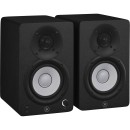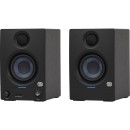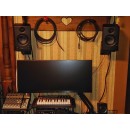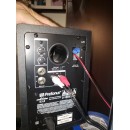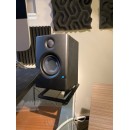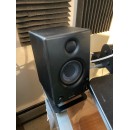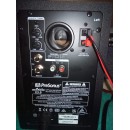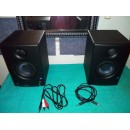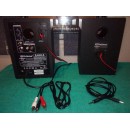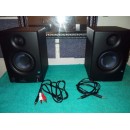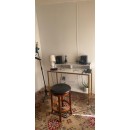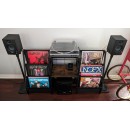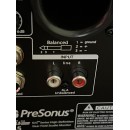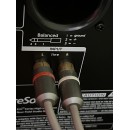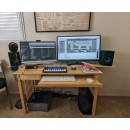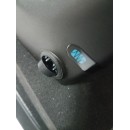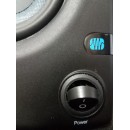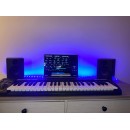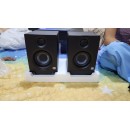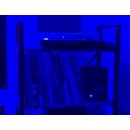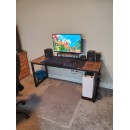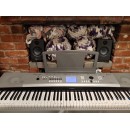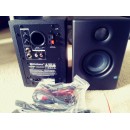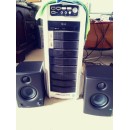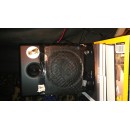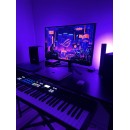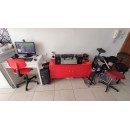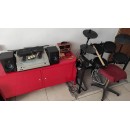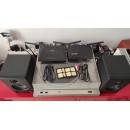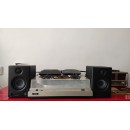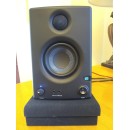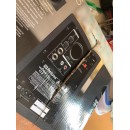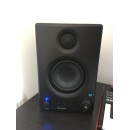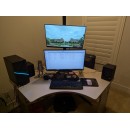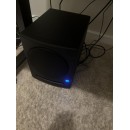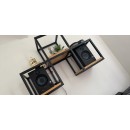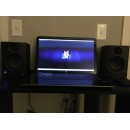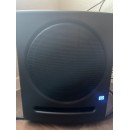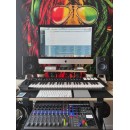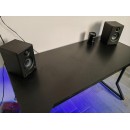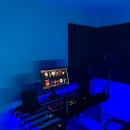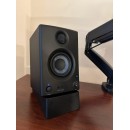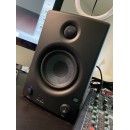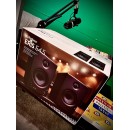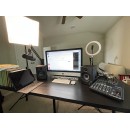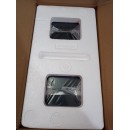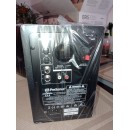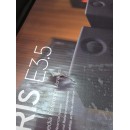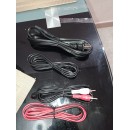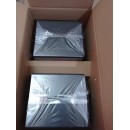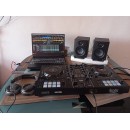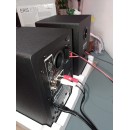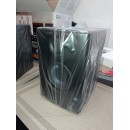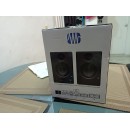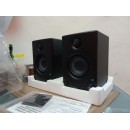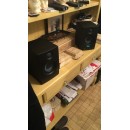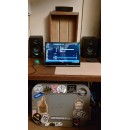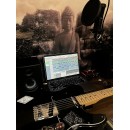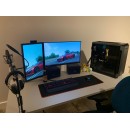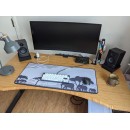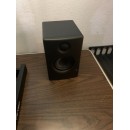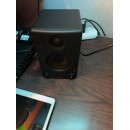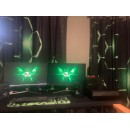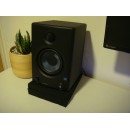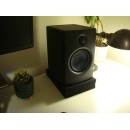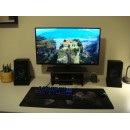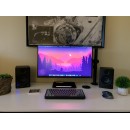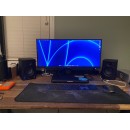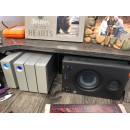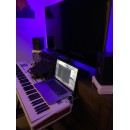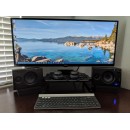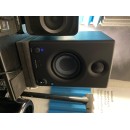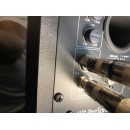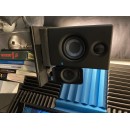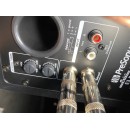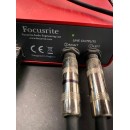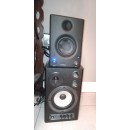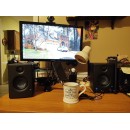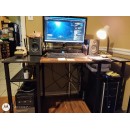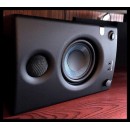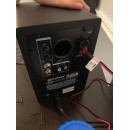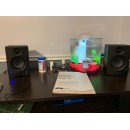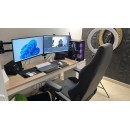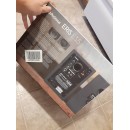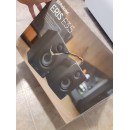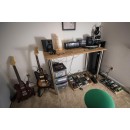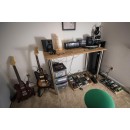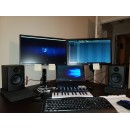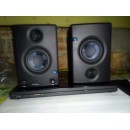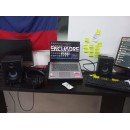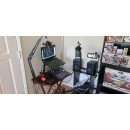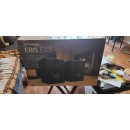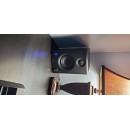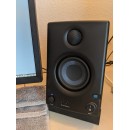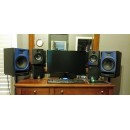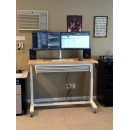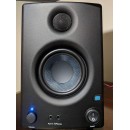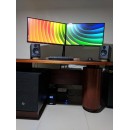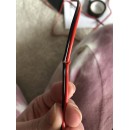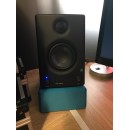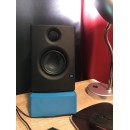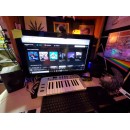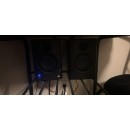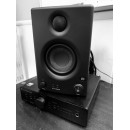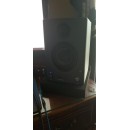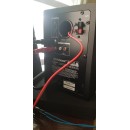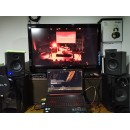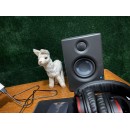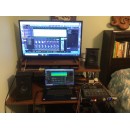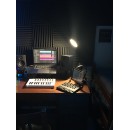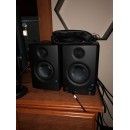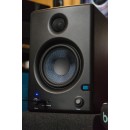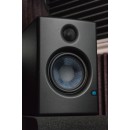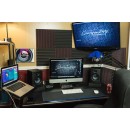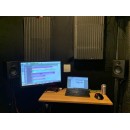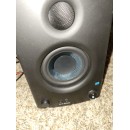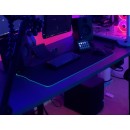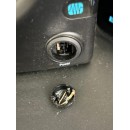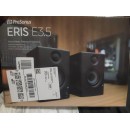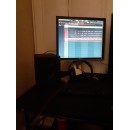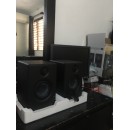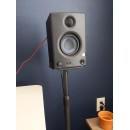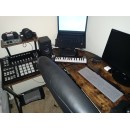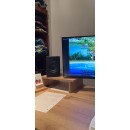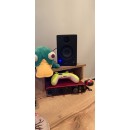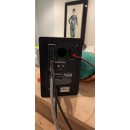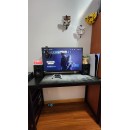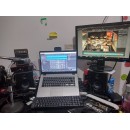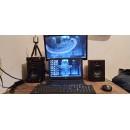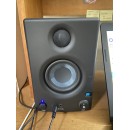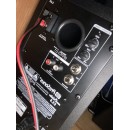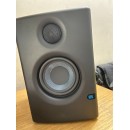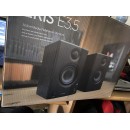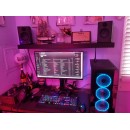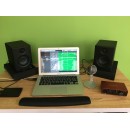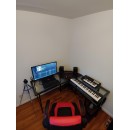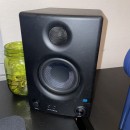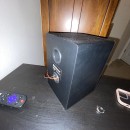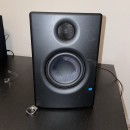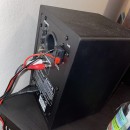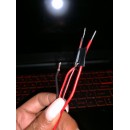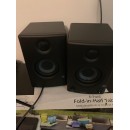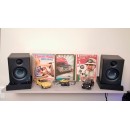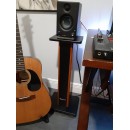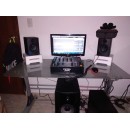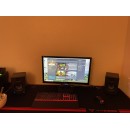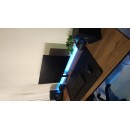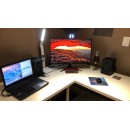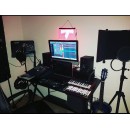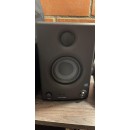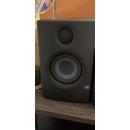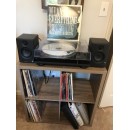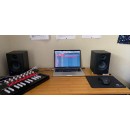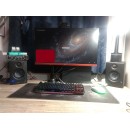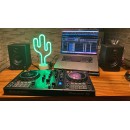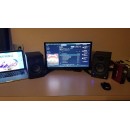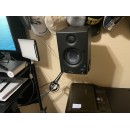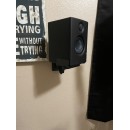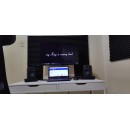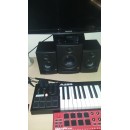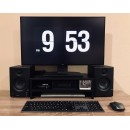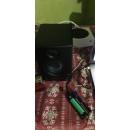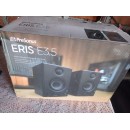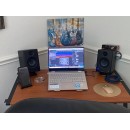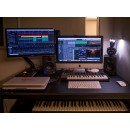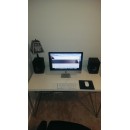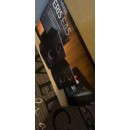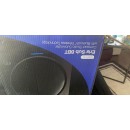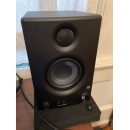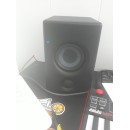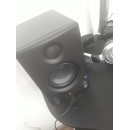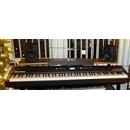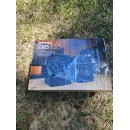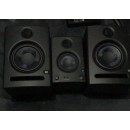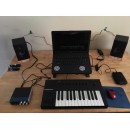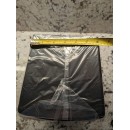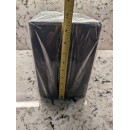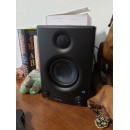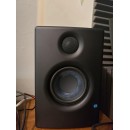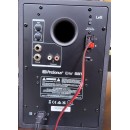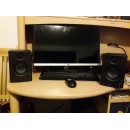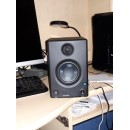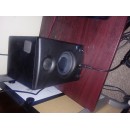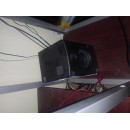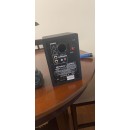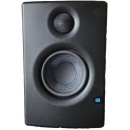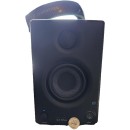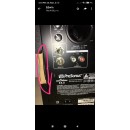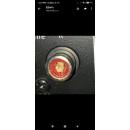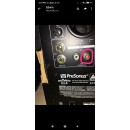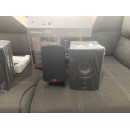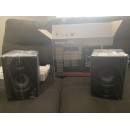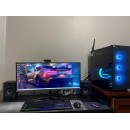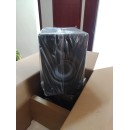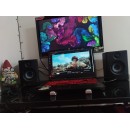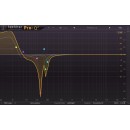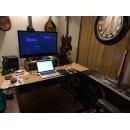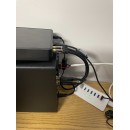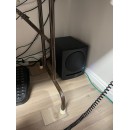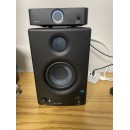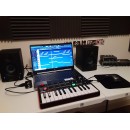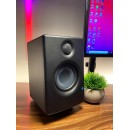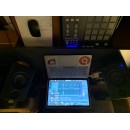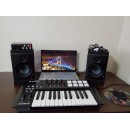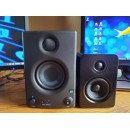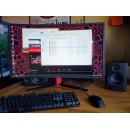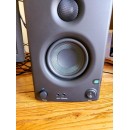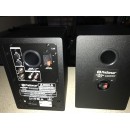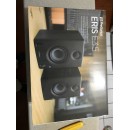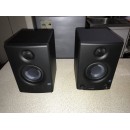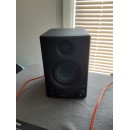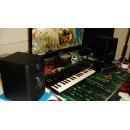PreSonus ERIS 3.5 vs Yamaha HS4: Which Studio Monitor Is Right for You?
The PreSonus ERIS 3.5 Studio Monitor Speaker and the Yamaha HS4 Studio Monitor are both popular choices among audio enthusiasts and professionals looking for reliable studio monitors. The PreSonus ERIS 3.5 is known for its compact size and affordability, making it a great option for smaller studios or home setups. It features a 3.5-inch Kevlar low-frequency driver and a 1-inch silk dome tweeter, providing a balanced and accurate sound. The ERIS 3.5 also includes acoustic tuning controls, allowing users to adjust the sound to fit their room acoustics, and offers multiple input options such as RCA, TRS, and an auxiliary input, enhancing its versatility.
On the other hand, the Yamaha HS4 Studio Monitor is part of the renowned HS series, known for its exceptional sound accuracy and performance. The HS4 features a 4-inch cone woofer and a 1-inch dome tweeter, delivering a precise and clear sound that is ideal for professional mixing and mastering. Yamaha's signature white-cone design is not just aesthetic but also ensures minimal distortion and a flat response. The HS4 is equipped with Room Control and High Trim response controls, allowing users to tailor the sound to their specific environment. Its build quality is robust, often preferred by professionals who require consistent and reliable performance over long periods.
In summary, if you're looking for a budget-friendly, compact option with decent sound quality and flexibility, the PreSonus ERIS 3.5 is a solid choice. It's particularly suitable for beginners or those with limited space. Conversely, the Yamaha HS4 is better suited for those who prioritize sound accuracy and quality, especially in a professional setting where precise audio monitoring is crucial. While the HS4 is generally more expensive than the ERIS 3.5, its performance justifies the investment for serious audio work. Both monitors have their strengths, and the choice ultimately depends on the specific needs and budget of the user.
In the following sections, we will delve into a comprehensive comparison of the specifications, advantages, and disadvantages of the PreSonus ERIS 3.5 and Yamaha HS4 studio monitors. Our detailed analysis will provide you with the insights needed to make an informed choice between these two popular options.
In-Depth Comparison of PreSonus ERIS 3.5 and Yamaha HS4
| User Rating Based on Analysis of Reviews | |
|---|---|
|
Show More |
| Pros: | |
|---|---|
|
|
| Cons: | |
|---|---|
|
|
| Key Specs | |
|---|---|
| Monitor Type & Configuration | |
| Active 2-Way | Active 2-Way |
| Total Power Output | |
| 26 W per Monitor | 25 W RMS per Monitor |
| Tweeter | |
| 1x 1" / 25.4 mm Dome | 1x 1" / 25.4 mm Silk Dome |
| Woofer | |
| 1x 4.5" / 11.4 cm Cone |
1x 3.5" / 11.4 cm Cone |
| Frequency Range | |
| 83 Hz to 20 kHz (-3 dB) 60 Hz to 22 kHz (-10 dB) |
80 Hz to 20 kHz |
| Audio I/O | |
| 2x Combo XLR-1/4" TRS Balanced Mic/Line Input (20 Kilohms) 1x 1/8" / 3.5 mm TRS Unbalanced Line Input (10 Kilohms) 1x Stereo 2RCA Unbalanced Line Input (10 Kilohms) 1x 1/8" / 3.5 mm TRS Speaker Input 1x 1/8" / 3.5 mm TRS Headphone Output 1x Binding Post Pair Speaker Output |
2x 1/4" TRS Balanced Input 1x Stereo 2RCA Unbalanced Input 1x 1/8" / 3.5 mm TRS Unbalanced Input 2x Binding Post Pair Output 1x 1/8" / 3.5 mm TRS Headphone Output |
| Digital Audio I/O | |
| Network I/O | |
| Wireless | |
When comparing the PreSonus ERIS 3.5 and Yamaha HS4 studio monitor speakers, both are active 2-way monitors designed for professional audio applications, but they differ slightly in specifications and performance. The PreSonus ERIS 3.5 features a total power output of 25 W RMS per monitor, while the Yamaha HS4 offers a marginally higher output at 26 W per monitor. This power difference may contribute to slight variations in volume and headroom during playback.Show More
In terms of driver configuration, the PreSonus ERIS 3.5 is equipped with a 3.5-inch cone woofer and a 1-inch silk dome tweeter, whereas the Yamaha HS4 utilizes a 4.5-inch cone woofer and a 1-inch dome tweeter. The larger woofer in the HS4 is likely to provide improved low-frequency response, with a frequency range of 60 Hz to 22 kHz (-10 dB) compared to the ERIS 3.5's 80 Hz to 20 kHz. This gives the HS4 an advantage in delivering a fuller bass response.
Both monitors offer a variety of audio input options. The PreSonus ERIS 3.5 includes 2x 1/4" TRS balanced inputs, a stereo 2RCA unbalanced input, and an 1/8" TRS unbalanced input. In contrast, the Yamaha HS4 provides 2x combo XLR-1/4" TRS balanced mic/line inputs, along with similar unbalanced inputs. This flexibility in connections makes the HS4 more versatile for various audio sources, giving it an edge in professional environments.
Ultimately, both the PreSonus ERIS 3.5 and Yamaha HS4 have their strengths, with the HS4 being slightly more powerful and capable of delivering better low-end performance, while the ERIS 3.5 offers a compact size ideal for smaller setups. Your choice may depend on your specific audio requirements and the space available for monitoring.
| General | |
|---|---|
| Number of Included Monitors | |
| Stereo Pair | Stereo Pair |
| Enclosure | |
| Bass-Reflex/Ported | Bass-Reflex/Ported |
| Total Power Output | |
| 26 W per Monitor | 25 W RMS per Monitor |
The PreSonus ERIS 3.5 Studio Monitor Speaker and the Yamaha HS4 Studio Monitor both come as a stereo pair, making them suitable options for studio monitoring. Each speaker features a bass-reflex/ported enclosure, which enhances low-frequency response and overall sound quality. This design allows for better performance in various listening environments, making both models appealing to audio professionals and enthusiasts alike.Show More
In terms of total power output, the PreSonus ERIS 3.5 delivers 25 W RMS per monitor, providing adequate power for smaller studios or personal setups. In contrast, the Yamaha HS4 edges ahead slightly with a total power output of 26 W per monitor. This marginal difference in wattage may provide the HS4 with a slight advantage in terms of volume and clarity, particularly in larger spaces.
Ultimately, while both monitors share similar features and designs, the choice between the PreSonus ERIS 3.5 and the Yamaha HS4 may come down to specific needs in terms of power output and brand preference. Each model presents a solid option for mixing and monitoring, catering to different user requirements without compromising on sound quality.
| Drivers per Monitor | |
|---|---|
| Tweeter | |
| 1x 1" / 25.4 mm Dome | 1x 1" / 25.4 mm Silk Dome |
| Woofer | |
| 1x 4.5" / 11.4 cm Cone |
1x 3.5" / 11.4 cm Cone |
| Amplifiers | |
| Full-Range: 26 W Class-D | Full-Range: 2 x 25 W RMS Class-AB |
When comparing the PreSonus ERIS 3.5 and Yamaha HS4 studio monitor speakers, both models feature a 1-inch dome tweeter crafted from silk for smooth high-frequency response. However, the key difference lies in the size of the woofers; the PreSonus ERIS 3.5 is equipped with a 3.5-inch cone woofer, while the Yamaha HS4 boasts a larger 4.5-inch cone woofer. This difference in woofer size may influence the bass response and overall sound output of each speaker.Show More
In terms of amplification, the PreSonus ERIS 3.5 features a dual amplifier design with 25 W RMS per channel in a Class-AB configuration, providing robust audio performance. On the other hand, the Yamaha HS4 offers a slightly lower power rating with 26 W Class-D amplification, which is more efficient. This might affect the dynamic range and headroom available when mixing or producing audio.
Overall, the choice between the PreSonus ERIS 3.5 and the Yamaha HS4 studio monitors will depend on your specific audio needs, particularly regarding the importance of bass response and amplification efficiency in your studio environment.
| Performance | |
|---|---|
| Frequency Range | |
| 83 Hz to 20 kHz (-3 dB) 60 Hz to 22 kHz (-10 dB) |
80 Hz to 20 kHz |
| Maximum Sound Pressure Level (SPL) | |
| 102 dB (Peak) | 97 dB |
The PreSonus ERIS 3.5 Studio Monitor Speaker offers a frequency range of 80 Hz to 20 kHz, making it suitable for a variety of audio applications. Its maximum sound pressure level (SPL) is rated at 97 dB, providing a decent output for smaller studio environments. Additionally, the speaker features output current limiting for protection, ensuring the longevity and reliability of the unit during high-performance scenarios.Show More
In contrast, the Yamaha HS4 Studio Monitor boasts a slightly broader frequency range of 83 Hz to 20 kHz (-3 dB) and extends down to 60 Hz to 22 kHz (-10 dB), offering enhanced low-frequency response compared to the PreSonus model. The HS4 achieves a higher maximum SPL of 102 dB (Peak), which can be advantageous in louder mixing environments. Furthermore, it supports a maximum input level of +20 dBu (Balanced) and +6 dBu (Unbalanced), providing more versatility for different audio sources.
Both studio monitors offer unique strengths, with the PreSonus ERIS 3.5 being ideal for compact spaces and a more limited budget, while the Yamaha HS4 presents enhanced performance specifications suited for professional audio production. Ultimately, the choice between the two will depend on the specific needs and environments of the user.
| Signal Processing | |
|---|---|
| EQ | |
| 1x LF Shelf: 0 to +4 dB at 500 Hz (2 dB Increments) 1x HF Shelf: 2 to -2 dB at 2 kHz (2 dB Increments) |
1x HF Shelf 1x LF Shelf |
| Phase Adjustment | |
The PreSonus ERIS 3.5 Studio Monitor Speaker features a simple EQ setup with a single high-frequency (HF) shelf and a single low-frequency (LF) shelf, allowing users to make basic adjustments to sound output. This straightforward EQ design makes it suitable for those who prefer minimal interference in their audio signal and want to maintain an accurate sound profile without extensive tweaking.Show More
In contrast, the Yamaha HS4 Studio Monitor offers a more advanced EQ configuration, featuring an LF shelf adjustable from 0 to +4 dB at 500 Hz in 2 dB increments, and an HF shelf that can be adjusted from 2 to -2 dB at 2 kHz, also in 2 dB increments. This provides greater flexibility for fine-tuning the sound to fit specific acoustic environments or personal preferences. Additionally, the HS4 has a crossover frequency set at 2.3 kHz, which can enhance the separation of frequencies for clearer audio reproduction.
Both monitors lack phase adjustment capabilities, which means that users will not be able to correct any phase issues that may arise in their monitoring setup. However, the more comprehensive EQ options of the Yamaha HS4 may appeal to users looking for enhanced control over their mixing environment, while the simplicity of the PreSonus ERIS 3.5 is ideal for those who prefer a more straightforward approach to studio monitoring.
| Connectivity | |
|---|---|
| Audio I/O | |
| 2x Combo XLR-1/4" TRS Balanced Mic/Line Input (20 Kilohms) 1x 1/8" / 3.5 mm TRS Unbalanced Line Input (10 Kilohms) 1x Stereo 2RCA Unbalanced Line Input (10 Kilohms) 1x 1/8" / 3.5 mm TRS Speaker Input 1x 1/8" / 3.5 mm TRS Headphone Output 1x Binding Post Pair Speaker Output |
2x 1/4" TRS Balanced Input 1x Stereo 2RCA Unbalanced Input 1x 1/8" / 3.5 mm TRS Unbalanced Input 2x Binding Post Pair Output 1x 1/8" / 3.5 mm TRS Headphone Output |
| Digital Audio I/O | |
| Network I/O | |
| USB | |
| Wireless | |
| Mobile App Compatible | |
The PreSonus ERIS 3.5 Studio Monitor Speaker features a variety of audio inputs, including 2x 1/4" TRS Balanced Inputs, 1x Stereo 2RCA Unbalanced Input, and 1x 1/8" / 3.5 mm TRS Unbalanced Input. Additionally, it offers 2x Binding Post Pair Outputs and a 1x 1/8" / 3.5 mm TRS Headphone Output. This range of connectivity options makes it suitable for various setup requirements, particularly for smaller studio environments. However, it lacks any digital audio, network I/O, USB, wireless capabilities, or mobile app compatibility.Show More
In contrast, the Yamaha HS4 Studio Monitor also provides a comprehensive set of audio inputs, featuring 2x Combo XLR-1/4" TRS Balanced Mic/Line Inputs which enhance its versatility for both microphones and line-level sources. It includes a 1x 1/8" / 3.5 mm TRS Unbalanced Line Input, a 1x Stereo 2RCA Unbalanced Line Input, and a 1/8" / 3.5 mm TRS Headphone Output. The HS4 also boasts a 1x Binding Post Pair Speaker Output, making it a robust option for various monitoring needs. Like the PreSonus model, it does not feature digital audio I/O, network capabilities, USB, wireless, or mobile app compatibility.
Overall, while both the PreSonus ERIS 3.5 and Yamaha HS4 share similarities in input options, the HS4's Combo XLR-1/4" TRS Inputs provide greater flexibility for professional audio setups. The PreSonus model is more compact and may appeal to those with limited space or simpler monitoring needs. Ultimately, the choice between these two monitors will depend on the specific requirements of the user and the intended application.
| Physical | |
|---|---|
| Color | |
| Black | Black |
| Monitor Orientation | |
| Vertical | Vertical |
| Dimensions (W x H x D) | |
| 5.9 x 9.4 x 8.4" / 15 x 23.9 x 21.3 cm (with Amplifier) 5.2 x 8.8 x 7" / 13.2 x 22.4 x 17.8 cm (without Amplifier) |
5.5 x 8.3 x 6" / 139.7 x 210.8 x 152.4 mm (Each) |
| Weight | |
| 8.2 lb / 3.7 kg (with Amplifier) 6.8 lb / 3.1 kg (without Amplifier) |
3.1 lb / 1.4 kg (Pair) |
The PreSonus ERIS 3.5 Studio Monitor Speaker is designed in a black finish and features a vertical monitor orientation. Its compact dimensions measure 5.5 x 8.3 x 6 inches (139.7 x 210.8 x 152.4 mm) for each speaker, making it suitable for smaller studio spaces. The total weight of the pair is 3.1 lb (1.4 kg), which contributes to its portability and ease of setup.Show More
In contrast, the Yamaha HS4 Studio Monitor also comes in a black color and maintains a vertical orientation. The dimensions are slightly larger, measuring 5.9 x 9.4 x 8.4 inches (15 x 23.9 x 21.3 cm) when including the amplifier. Without the amplifier, the size is 5.2 x 8.8 x 7 inches (13.2 x 22.4 x 17.8 cm). The HS4 is heavier, weighing 8.2 lb (3.7 kg) with the amplifier and 6.8 lb (3.1 kg) without, which may affect portability but provides a solid build quality.
Both monitors are constructed with a vertical orientation and a black finish, making them aesthetically compatible in most studio setups. However, the PreSonus ERIS 3.5 is more compact and lightweight, making it ideal for mobile setups or smaller spaces. In contrast, the Yamaha HS4 offers a more substantial build and potentially better sound performance due to its larger size and enclosure material made of MDF, which generally enhances sound quality and reduces unwanted resonance.
| Packaging Info | |
|---|---|
| Package Weight | |
| 18.655 lb | 8.785 lb |
| Box Dimensions (LxWxH) | |
| 13 x 12.9 x 11.7" | 15.4 x 11.5 x 8.9" |
The PreSonus ERIS 3.5 Studio Monitor Speaker boasts a package weight of 8.785 lb, making it a lightweight option for those who require portability without sacrificing sound quality. Its box dimensions measure 15.4 x 11.5 x 8.9", which allows for easy placement in smaller studio spaces or home environments. This compact design is ideal for users who need a reliable monitor that can fit into tight areas while still delivering accurate audio playback.Show More
In contrast, the Yamaha HS4 Studio Monitor has a significantly heavier package weight of 18.655 lb, indicating a more robust build that may provide enhanced durability and stability. Its box dimensions of 13 x 12.9 x 11.7" suggest a more standard size for studio monitors, allowing it to fit comfortably into most studio setups. While it is heavier, this may contribute to superior sound performance, especially in professional audio environments.
In summary, the PreSonus ERIS 3.5 is designed for those who prioritize portability and compactness, making it suitable for on-the-go setups or smaller spaces. Meanwhile, the Yamaha HS4 offers a more substantial presence, likely appealing to users who value durability and professional-grade sound quality in a studio monitor. Each speaker caters to different needs and preferences, making them both strong contenders in the studio monitor market.
| Customer Images | |
|---|---|
|
|
|
| Videos | |
|---|---|
|
|
|
